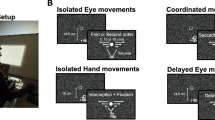Abstract
Previous research has shown that even when limb position drifts considerably during continuous blind performance, the topological and metrical properties of generated hand paths remain remarkably invariant. We tested two possible accounts of this intriguing effect. According to one hypothesis, position drift is due to degradation of limb-position information. This hypothesis predicted that drift of static hand positions at movement reversals should not depend on movement speed. According to the other hypothesis, position drift is due to degradation of movement information. This hypothesis predicted that drift of static hand positions at movement reversals should vary with movement speed. We tested these two hypotheses by varying the required movement speed when normal human adults performed back-and-forth manual positioning movements in the absence of visual feedback. Movement distance and direction were well preserved even though hand positions between movements drifted considerably. In accord with the movement error hypothesis, but not in accord with the position hypothesis, the rate at which hand positions drifted depended on movement speed. The data are consistent with the idea that hand position, which defines the origin of the trajectory control coordinate system, and movement trajectory are controlled by distinct neural mechanisms.







Similar content being viewed by others
References
Adams HF(1912) Autokinetic sensations. Psychol Monogr 14:1–45
Bock O, Arnold K (1993) Error accumulation and error correction in sequential pointing movements. Exp Brain Res 95:111–117
Bock, O, Eckmiller R (1986) Goal directed arm movements in absence of visual guidance: evidence for amplitude rather than position control. Exp Brain Res 62:451–458
Bock O, Dose M, Ott D, Eckmiller R (1990) Control of arm movements in a 2-dimensional pointing task. Behav Brain Res 40:247–250
Brown LE, Rosenbaum DA (2001) Coordinate systems for movement planning: evidence from positional drift. Psychon Soc Abstr 6:16
Brown LE, Rosenbaum DA, Sainburg RL (2003) Limb position drift: implications for control of posture and movement. J Neurophysiol (in press)
Desmurget M, Vindras P, Grea H, Viviani P, Grafton ST (2000) Proprioception does not quickly drift during visual occlusion. Exp Brain Res 134:363–377
DiZio P, Lackner JR (1995) Motor adaptation to Coriolis force perturbations of reaching movements: endpoint but not trajectory adaptation transfers to the nonexposed arm. J Neurophysiol 74:1787–1792
DiZio P, Lackner JR (2001) Coriolis-force-induced trajectory and endpoint deviations in the reaching movements of labyrinthine-defective subjects. J Neurophysiol 85:784–789
Fel'dman AG (1986) Once more on the EPH (λ model) for motor control. J Mot Behav 18:17–54
Georgopoulos AP (1995) Current issues in directional motor control. Trends Neurosci 18:506–10
Georgopoulos AP (2000) Neural aspects of cognitive motor control. Curr Opin Neurobiol 10:238–241
Ghez C, Hening W, Gordon J (1991) Organization of voluntary movement. Curr Opin Neurobiol 1:664–671
Ghilardi MF, Gordon J, Ghez C (1995) Learning a visuomotor transformation in a local area of work space produces directional biases in other areas. J Neurophysiol 73:2535–2539
Gordon J, Ghez C (1987a) Trajectory control in targeted force impulses. II. Pulse height control. Exp Brain Res 67:241–52
Gordon J, Ghez C (1987b) Trajectory control in targeted force impulses. III. Compensatory adjustments for initial errors. Exp Brain Res 67:253–69
Gordon J, Ghilardi MF, Ghez C (1994) Accuracy of planar reaching movements. I. Independence of direction and extent variability. Exp Brain Res 99:97–111
Graziano MSA (1999) Where is my arm? The relative role of vision and proprioception in the neuronal representation of limb position. Proc Natl Acad Sci USA 96:10418–10421
Graziano MS, Taylor CSR, Moore T (2002) Complex movements evoked by microstimulation of precentral cortex. Neuron 34:841–851
Kakei S, Hoffman DS, Strick PL (1999) Muscle and movement representations in the primary motor cortex. Science 285:2136–2139
Kalaska JF (1988) The representation of arm movements in postcentral and parietal cortex. Can J Physiol Pharmacol 66:455–463
Kalaska JF, Caminiti R, Georgopoulos AP (1983) Cortical mechanisms related to the direction of two-dimensional arm movements: relations in parietal area 5 and comparison with motor cortex. Exp Brain Res 51:247–260
Lackner JR, DiZio P (1994) Rapid adaptation to Coriolis force perturbations of arm trajectory. J Neurophysiol 72:299–313
Marteniuk RG, Roy EA (1972) The codability of kinesthetic location and distance information. Acta Psychol 36:471–479
Miall RC, Haggard PN, Cole JD (1995) Evidence of a limited visuo-motor memory used in programming wrist movements. Exp Brain Res 107:267–280
Oldfield RC (1971) The assessment and analysis of handedness: the Edinburgh Inventory. Neuropsychologia 9:97–113
Paillard J, Brouchon M (1968) Active and passive movements in the calibration of position sense. In: Freedman SJ (ed) The neuropsychology of spatially oriented behavior. Dorsey Press, Homewood IL
Rosenbaum DA (1980) Human movement initiation: specification of arm, direction, and extent. J Exp Psychol Gen 109:444–474
Rosenbaum DA, Meulenbroek R, Vaughan J, Jansen, C (2001) Posture-based motion planning. Psychol Rev 108:709–734
Sainburg RL, Kalakanis D (2000) Differences in control of limb dynamics during dominant and nondominant arm reaching. J Neurophysiol 83:2661–2675
Sainburg RL, Wang J (2002) Interlimb transfer of visuomotor rotations: independence of direction and final position information. Exp Brain Res 145:437–447
Sainburg RL, Lateiner JE, Latash M, Bagesteiro LB (2003) Differential contributions of proprioception and vision to vectorial representations in reaching. J Neurophysiol 89:401–415
Sittig AC, Denier Van Der Gon JJ, Gielen CCAM, Van Wijk AJM (1985) The attainment of target position during step-tracking movements despite a shift of initial position. Exp Brain Res 60:407–410
Smyth MM (1984) Memory for movements. In: Smyth MM, Wing AM (eds) The psychology of human movement. Academic Press, London, pp. 83–117
van Beers RJ, Sittig AC, Denier von der Gon JJ (1998) The precision of proprioceptive position sense. Exp Brain Res 122:367–377
van Beers RJ, Sittig AC, Denier von der Gon JJ (1999) Integration of proprioceptive and visual position information: an experimentally supported model. J Neurophysiol 81:1355–1364
van den Dobbelsteen JJ, Brenner E, Smeets JBJ (2001) Endpoints of arm movements to visual targets. Exp Brain Res 138:279–287
Verschueren SMP, Swinnen SP, Cordo PJ, Dounskaia NV (1999) Proprioceptive control of multijoint movement: unimanual circle drawing. Exp Brain Res 127:171–181
Wann JP, Ibrahim SF (1993) Does limb proprioception drift? Exp Brain Res 91:162–166
Wolpert DM, Goodbody SJ, Husain M (1998) Maintaining internal representations: the role of the human superior parietal lobe. Nat Neurosci 1:529–533
Zelaznick HN, Lantero D (1996) The role of vision in repetitive circle drawing. Acta Psychol 92:105–118
Acknowledgements
This study was supported by grant #R01-HD39011 awarded to RLS by NIH-NICHHD (US National Institutes of Child Health and Human Development).
Author information
Authors and Affiliations
Corresponding author
Rights and permissions
About this article
Cite this article
Brown, L.E., Rosenbaum, D.A. & Sainburg, R.L. Movement speed effects on limb position drift. Exp Brain Res 153, 266–274 (2003). https://doi.org/10.1007/s00221-003-1601-7
Published:
Issue Date:
DOI: https://doi.org/10.1007/s00221-003-1601-7




